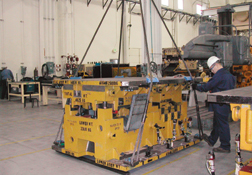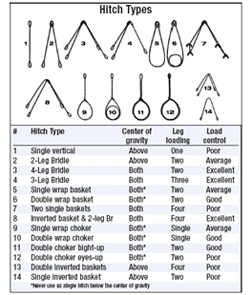Crane Failures Have Industry Looking at Hazards Under the Hook
 Industrial Training International INC Parnell investigated a West Coast sling failure caused by a worn-out lifting hook. |
Master rigger Mike Parnell walks up to a rack and picks up what looks like a giant rubber band. In reality, it is a 10-ft-long, 2-in.-wide lifting sling made of thin, yellow nylon webbing. Parnell runs his fingers over the pilled, faded, oil-stained surface. “Your hands will tell you more than your eyes,” he says, as he flips the material over for further inspection. Under the roof of a Chicago-area manufacturing plant, Parnell puts down the strap, wipes his hands on his jeans and concludes that the sling needs to be replaced.
“It’s given its life,” says Parnell, president of Industrial Training International Inc., a Woodland-Wash.-based lift-and- rigging consulting company. He later inspects several other slings inside the factory and fails them, too. Workers might continue to put the slings into service, so Parnell advises someone on the factory floor to get replacements. As Parnell talks, the worker nods his head and then goes back to assembling.
Companies hire experts like Parnell to evaluate risks, but he also gets involved as a forensic expert when things go wrong. As an inspector, “My job is to expose the wounds and warts,”says Parnell. “I’m not going to do them any good by being a nice guy.” The 2-in. sling may cost the owner $50 to replace, but it could end up costing much more if it broke during a lift. Nine times out of 10, slings and other rigging fail because they were not used properly, Parnell and others say.
|
Naturally, the controlled environment of a factory is not the ever-changing landscape of construction. But the principles of safe rigging—using strong hitches, minding a load’s center of gravity, selecting the right sling, calculating capacity under different load angles, and throwing out damaged hardware—are the same. In the aftermath of deadly high-rise building accidents in Manhattan and Miami that caused tower-crane pieces to rain down into the streets and apartments below, trainers, inspectors and employers are paying more attention to rigging hazards under the hook.
Some are calling for certification of riggers and crane erectors. Others are scrutinizing synthetic slings, made of nylon or polyester, which forensic experts say are often misused and improperly maintained. The slings are easier to handle than heavier ones, but are safe if used properly, they say. Rigging experts also note that more attention should be paid to training craft workers in basic lifting gear, such as shackles, chains and hooks. A quick inspection will indicate whether they are ready to go onto the hook or into the garbage.
Recipe for Disaster
 AP/Wideworld |
 AP/Wideworld Top collar slid into tie-ins below, knocking out support. Photos show minimal rigging attached to the assembly (see arrows) |
Clues into the recent accidents (both are still under investigation) point more to failures in rigging rather than the operation of the cranes. In Miami, a tower crane’s vertical mast section, which is secured with rigging before it is bolted into place, fell during a tower-climbing maneuver. In New York, a crane toppled when its lateral supports—also secured with temporary rigging—slipped and fell just before a climb.
Making sure crews are on the same page before a climb, and having the necessary rigging available, is the key to safety, contractors say. “It has to be planned,” says John Langford, corporate safety director for Chicago-based James McHugh Construction Co.
Before climbing a tower crane, riggers or ironworkers first install a square beam assembly called a “collar” that wraps around the crane’s vertical mast. They then bolt it to “struts,” beams that act like a “leash” tying the crane to the building. Manufactuers require collars installed at varying floors as the project progresses in order to ensure stability.
Workers climb the crane using an intricate set of hydraulic jacks and modular tower sections. It is a delicate procedure: When the top of the crane is jacking up, its turntable, horizontal jib and counterweight are all bolstered by temporary supports and hardware. “You got a lot riding on that rigging,”says Mike Drew, a veteran crane operator and training instructor for operating engineers’ union Local 150 in Chicago.
A source close to the New York accident, which killed seven people, says a mix of improper rigging and sling selection likely led to the failure. “It’s not a crane problem, it’s a problem with the rigging procedure,” says the source, who asked not to be named. Photography and other materials that ENR obtained confirm that something went terribly wrong with the rigging. Crews were preparing to jump the jib superstructure by attaching a new collar, which comes from the factory in two C-shapes that bolt together. Two come-alongs (hand-operated blocks with chains) were shackled to lifting lugs welded on top of the collar. The come-alongs were supported by two nylon web slings hung from the tower’s mast members above.
Pictures after the accident show the come-alongs still dangling from the collar, which had lost support and slid to the ground, knocking out lower collar supports. Cut and tensile-torn nylon slings appear to be hanging from the chain-block hooks. Wires twisted around the collar also appear to have supported part of the assembly while it was still in the air.
While tower-crane makers typically specify one or more slings on each leg of the collar, the New York collar appears to have been minmally supported. Rigging experts also note that cuts from hard edges (and tower crane chords would apply) are a common cause of sling failure. “Too often, we’re pairing the wrong rigging...
...material for the application,” says Parnell. He adds that the movement between synthetic slings and fabricated steel can be “deadly.” Softeners, or edge protectors, can keep a sling from rubbing against the load and extend its life.
 AP/Wideworld Miami investigation centers on slipped tower section. |
Under normal circumstances, chain blocks and slings (crane manufacturers typically do not specify the type of sling) would hold the collar during the process, and they would remain in place until the crane is disassembled to act as a failsafe. During the crane-jumping process, the come-alongs also serve a practical need, as workers use the hand ratchets to adjust the height and position of the collar so it can line it up with the strut shoes.
But workers can get in trouble fast in such maneuvers if standard practice is thrown out the window. Poor choices would erode away the strong factors of safety normally built into what normally is a highly engineered task. “This was a recipe for disaster,” says the source.
Workers may overlook rigging because they feel pressure to move the job along by using old, worn out hardware or whatever was available in the gang box at the time of the lift. Whatever the case, “It doesn’t make good sense in human or in dollar cost to cut corners,” says Bradley D. Closson, president of Bonita, Calif.-based CRAFT Forensic Services Inc.
Education Deficit
Employers, too, may put little emphasis on educating workers about the dangers. Today’s culture of corporate safety tends to focus on general accident prevention, such as wearing hardhats and reading material-safety-data sheets. Rigging, though employed by all trades, is often treated like a speciality even though it has the potential to harm many people and damage much property.
 Guy Lawrence / ENR |
 Linton Rigging Gear Supply Smart riggers use edge protectors, or load �softeners,� to keep slings protected (above) |
Yet construction hangs much of its work on the hook. “A crane cannot make a lift without some sort of rigging,” explains Closson, who has been retained to investigate the New York accident (but is not speculating on causes). He adds that employers in construction need to spend more time on rigging training. “We will beat people to death with reading the Material Safety Data Sheets. We’ll tell them how to lift a box,” he explains. “We’ll talk about ladder safety, holes in decks, electrical tool safety. Then, we’ll talk about slings—maybe once.”
Langford adds that slings come out of the factory with big factors of safety built in, giving workers a false sense of security. Todd Negus, president of Olympic Synthetic Products, Sequim, Wash., explains that nylon web slings are built to withstand five times more weight than their ratings. That makes for super-safe rigging devices, Langford notes, but he says it creates a potential hazard: “It’s easy to overload it without breaking it. And that leads people to develop bad habits.”
Rigging failures also are often the result of neglect. In a West Coast accident that Parnell investigated in 2005, a contractor rigged two web slings in basket hitches to lift a 19,000-lb skid. One sling broke at the eye, dropping the load. No one was hurt, but a factory pull test on the other sling found that it snapped at 50% of its design strength because it was already faded and overused. Even so, the slings might have scraped by without breaking. One sling broke because the hook was previously damaged from steel hardware, creating a razor-sharp edge.
Makers of lifting slings—nylon web, polyester roundslings, chain and wire rope—say those safety factors protect them from liability, as workers tend to abuse the gear. But construction is extra rough on rigging, especially soft slings. “Normally, they beat the crap out of the sling, then put a surge on it,” says Parnell.
| + click to enlarge |
 Chart: Industrial Training International INC |
Synthetic slings are especially hazardous when wrapped around hard materials, even when some edges don’t look sharp. “Cutting is related to weight or force,” Closson explains. “We learned this basically in the third grade, when Mom brought out the stick of butter that was in the refrigerator rock hard. You took a knife and tried to cut it. The harder you pushed, the more it pushed through. People will look at a piece of angle iron, run their hand across it, come back without a bloody stump and think it is OK.”
Manufacturers, such as Sellersburg, Ind.-based Linton Rigging Gear Supply LLC, make edge protectors that help prevent cutting.
Its magnetic wear pads cost about $700 for a set of four. “Even though my softeners are expensive they pay back what you save on slings,” says Ray Linton, president. Chain and wire rope slings should also be protected, he adds.
Rigging may seem like an easy job, but it is best left to those who know what they are doing. Calculating load capacity, center of gravity and hitch angle should be done under the supervision of an experienced crew member because carelessness and ignorance leads to mistakes. Training can make the difference between a safe lift and a disaster: “There are three to five good ways to rig almost any load,” says Parnell. “And two or three bad ways.”
 Related Link:
Related Link: